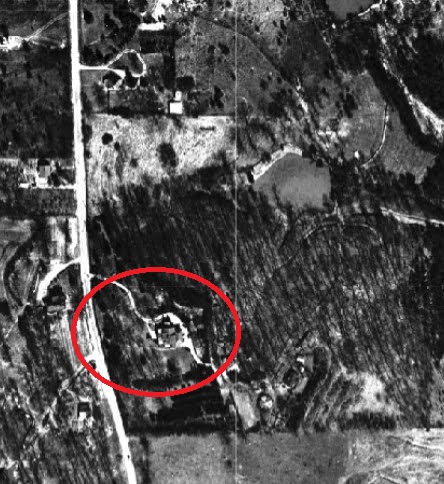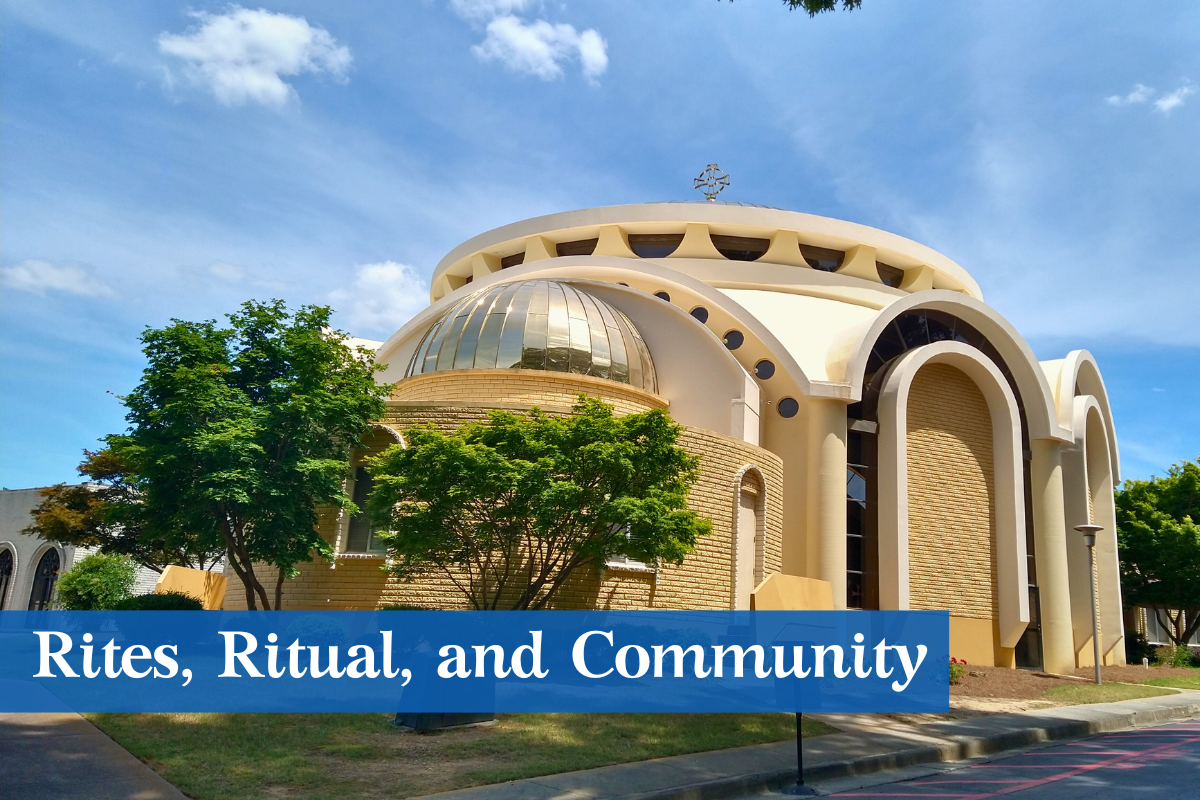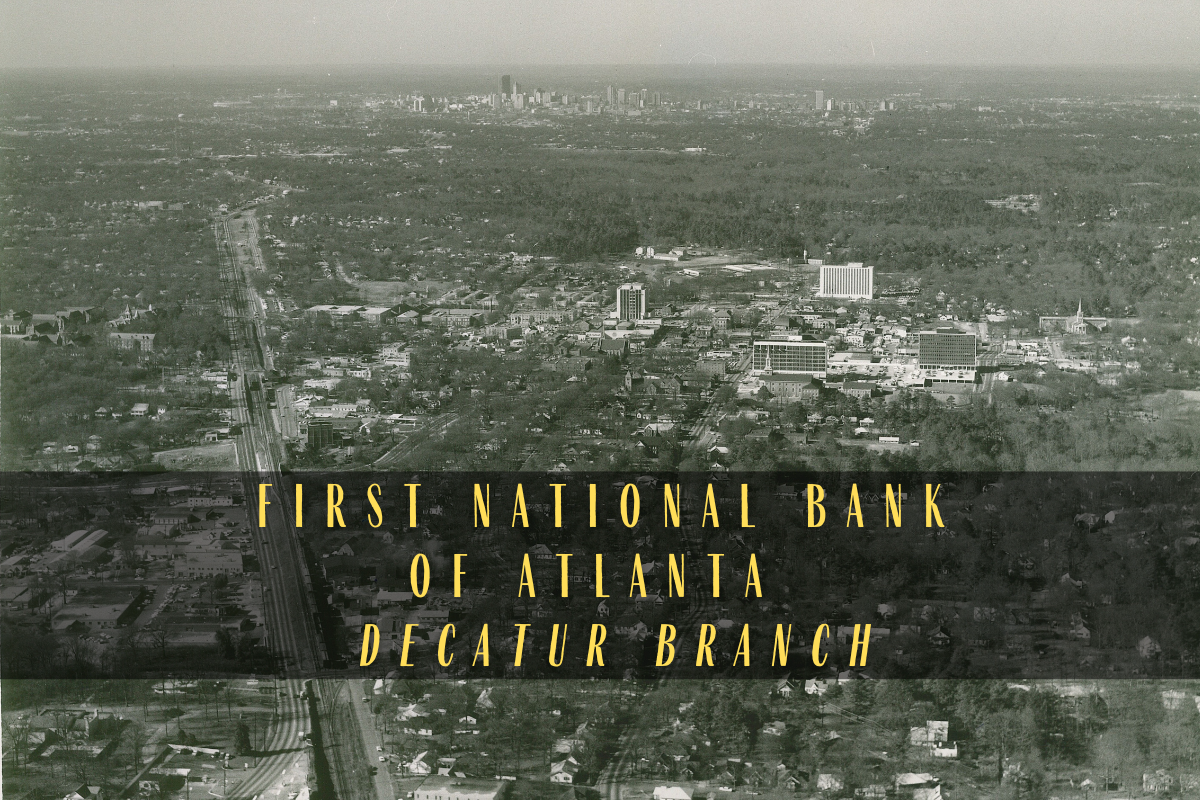Bouldercrest Road History
By Marissa Howard, Programs and Membership Coordinator
Learn the history and origin of the names Boulder Crest, and Bouldercrest Road. Featured image is Bouldercrest School, ca 1937. Rainey Collection, DeKalb History Center.
Bouldercrest/ Boulder Crest have been used interchangeably throughout the years to describe the road and elementary school.
“Boulder Crest” was the summer home and large estate of Dr. Elmore Calloway Thrash. Dr. Thrash was a prominent leader in the medical community of Atlanta. His country home, built in 1916, was a sprawling estate, over 165 acres off of what was then called East McDonough Road. The property was located just south of the intersection of Fayetteville, Flat Shoals, Eastland, and Brannen Roads. He described the home as similar in style to the Grove Park Inn (today Omni Grove Park) in Asheville, NC. However, that “style” was not specified, other than the stone façade.

The Atlanta Journal, October 29, 1922.
He invited 100 physicians to the grand opening of Boulder Crest via a public announcement in The Atlanta Constitution.
“You are hereby ordered to lay aside all other business, exactly at 1:30 … ride out to East Atlanta along East McDonough Road until you come to a stone house on the left. There stop, sniff, and if you smell barbecue, drive in.”
The Atlanta Constitution, October 14, 1916.
Could you imagine reading in the newspaper that your doctor canceled their appointment with you because they followed their nose to a housewarming party?!
The home hosted society events and weddings including one for his daughter, Sappho Dobbs.
In 1919 he opened Boulder Crest Nursery. The nursery, located next door, was already home to an antebellum house that had belonged to the Akers Family, known as Akers Plantation, or “Ashby Hall.”
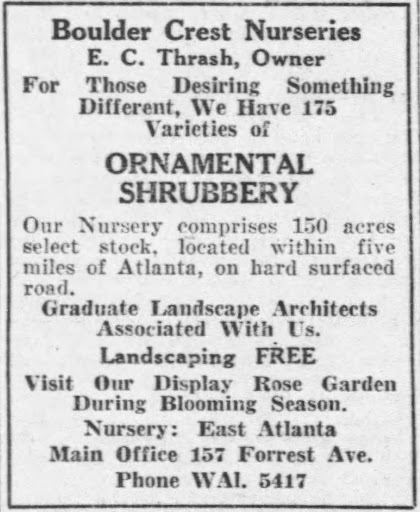
The Atlanta Constitution, January 30, 1930.
The Akers Family
The Akers were one of the early pioneering families of Atlanta. Nancy Mathew Akers and Judge William Akers settled on this property in the late 1840s, raising seven children including John Henry, George Washington, Franklin Pierce, and James K. Polk. The larger extended family was involved with many businesses in Atlanta, most famously Akers Brother Milling and Grain Company, known today as Akers Mill in Cobb County. Many family members are buried in Sylvester Cemetery in East Atlanta including Nancy Akers (d. 1899) and Judge William Akers (d.1858).
Nancy Matthew Akers, also called Grandma Akers, lived in the home until right before she died in 1899. Widowed in 1858, Nancy Akers was not wealthy. She continued to operate a farm and gristmill after the war. Of course, there is a Civil War story. The story goes: she took in wounded “Yankee” soldiers after the Battle of Atlanta. Federal troops created a picket line around the home to prevent it from being destroyed. Later, General Walker and General Cleburne’s men struggled along the same stretch of road and she tended to the Confederate soldiers. The Akers home was supposedly depicted in the Cyclorama with Union soldiers imprisoned in the stable yard.
The Akers property was described by son Franklin Pierce in 1927 as a Colonial Revival style mansion, with a square roof supported by huge columns and a row of boxwoods on either side of a gravel walk. An avenue of trees led to the front door, but it was in “bad need of repairs.”
The Akers family sold the property in 1909 to Dr. Thrash who converted it into a plant nursery called Boulder Crest Nurseries.
Boulder Crest Nurseries became a thriving business. Dr. Thrash continued to be involved in the medical field while he operated the nursery along with a partner, Jessie Brannen.
Dr. Thrash and his family began living in the home, Boulder Crest, full time by the late 1920s. He died in his house in 1931. Before moving away, his widow, Lucy Crouch, and daughter Sappho, donated the Akers boxwoods to St. Philips Cathedral in honor of their late father. The relocated boxwoods from the old Akers property were supposedly “spared” by Sherman’s troops and were said to be 100 years old. This image was published in the newspaper in 1934, along with an article about the boxwoods being transplanted to St. Philips. The photo does not align with the vivid description of the Akers home as told by Franklin Pierce just seven years prior.
The Akers house pictured in 1934.

The Atlanta Journal, Jul 08, 1934.
Sappho and Lucy were killed in a horrific car accident in 1936. In Sappho’s obituary, friends mentioned that Dr. Thrash’s home burned down shortly after his death. However, confusingly, the Brannen family, sole proprietors of Boulder Crest Nurseries (former Akers home) purchased Boulder Crest (former Thrash home). I am unsure what home if any burned down. If the Thrash home (remember the grand stone mansion) did burn down, then how was it possible weddings were continually hosted at “Boulder Crest” by the Brannen family?
Boulder Crest Nurseries thrived under Jesse Brannen, boasting 60 acres, and 129 varieties of hardy trees and shrubbery. It was also home to 2,000 rose bushes of over 20 varieties. They offered landscaping services and built example rock gardens so customers could see their designs.
Sappho and Lucy were killed in a horrific car accident in 1936. In Sappo’s obituary, friends mentioned that Dr. Thrash’s home burned down shortly after his death. However, confusingly, the Brannen family, sole proprietors of Boulder Crest Nurseries (former Akers home) purchased Boulder Crest (former Thrash home). I am unsure what home if any burned down. If the Thrash home (remember the grand stone mansion) did burn down, then how was it possible weddings were continually hosted at “Boulder Crest” by the Brannen family?
Boulder Crest Nurseries thrived under Jesse Brannen, boasting 60 acres, and 129 varieties of hardy trees and shrubbery. It was also home to 2,000 rose bushes of over 20 varieties. They offered landscaping services and built example rock gardens so customers could see their designs.
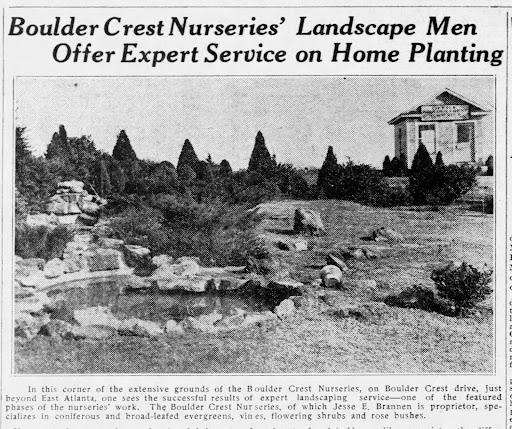
The Atlanta Constitution, January 15, 1934.
The road was renamed Boulder Crest Road from East McDonough Road sometime in the early 1930s. Boulder Crest Nurseries closed by 1940, and the last remaining Brannen family member moved out of Boulder Crest by 1950.
Brannen Road and Cecilia Drive, which cut through part of the property, are named after the Brannen family.
Not much is known about the property after that. Nothing remains of Boulder Crest, Boulder Crest Nursery, nor the Akers home. I can’t even be certain of the exact location.
One glimmer remains: an aerial photo from 1949 that shows a very large square home amongst landscaping and ponds.
